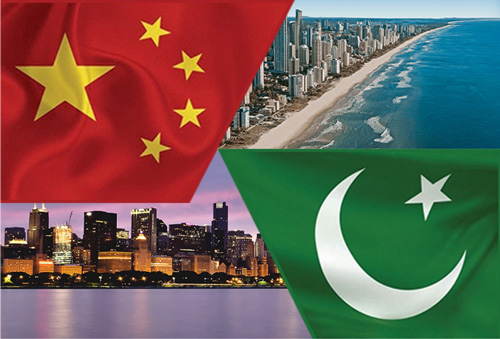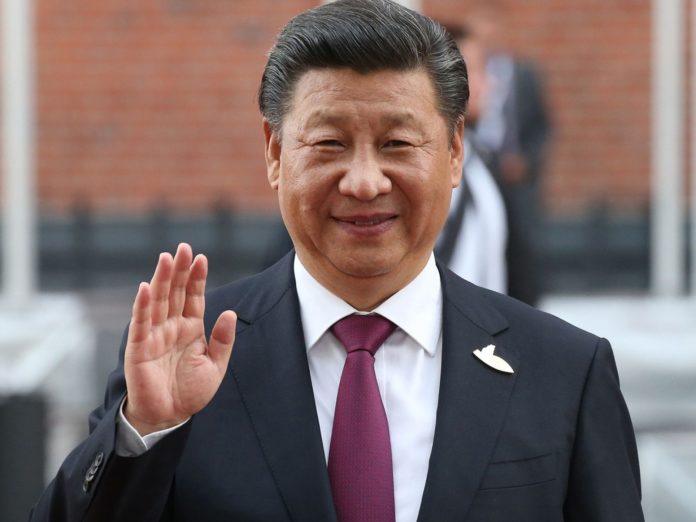With the Pacific Ocean dominated by the US and Japan while the Indian Ocean by the US (conceivably along with its new ally India), China has to turn to its centuries old land routes. As far back as the 11th century, Genghis Khan was exhorting his generals not to depend upon the seas but upon merchants and land routes for trade. In 1941 Japan went to war being denied sea access to sources of raw material in South and Southwest Asia. An efficient network of land, sea and air passages in Asia, Europe and Africa, that would not be prone to intervention by hostile powers during times of crisis, the “One Belt one Road” (OBOR) strategic initiative was thus launched by the Chinese President Xi Jinping in 2013.
The OBOR initiative is geographically structured along six corridors viz (1) western China to western Russia (2) northern China to eastern Russia via Mongolia (3) western China to Turkey via central and west Asia. The sea passages are (4) from southern China to Singapore via Indochina (5) India via Bangladesh and Myanmar. Important for us is the land passage over the Karakorams from (6) south-western China to and through Pakistan, the China Pakistan Economic Corridor (CPEC). Envisaging geo-economic and geo-political initiative, CPEC drastically increases the geo-strategic importance of Pakistan, bringing it into a central nodal position between Asia, South Asia and Central Asia. Connecting about 64 countries in three continents. Recreating the legendary Silk Road, OBOR’s purpose is (1) Policy coordination promoting inter-governmental cooperation and assisting policy exchange and communication; (2) Facilities connectivity to carry out infrastructure projects, e.g. relating to transportation and energy; (3) Unimpeded trade encouraging cross-border investments and reducing trade barriers; (4) Financial integration developing the currency and bond markets in Asia; and (5) People-to-people bonds facilitating cultural exchange through cooperation in academia, tourism, medicine, science and technology.
CPEC’s 3218 km long Corridor from China’s Xinjiang Province passing through Gilgit Baltistan to Pakistan’s Gwadar port will provide the shortest and most cost effective route for landlocked Afghanistan (and Central Asia) to China, India and Indian Ocean. Consisting of highways, railways and pipelines its estimated cost is US$75 billion. Other OBOR projects around the world do not offer the same advantages to China. Distance would be approx. 600 kilometres less as compared to the other nearest port of Chabahar. Transportation time would be reduced by 50 % from 50 days to 25 days. Gwadar port can also be used as a hub port for the Gulf States.
Building Pakistan’s transportation and power sectors with its resultant economic fallout, Foreign Direct Investment (FDI) will have a force-multiplier effect on employment development of many poverty-stricken areas. In his recent talk at a CPEC Seminar Dr. Ishrat Husain former Governor State Bank of Pakistan elaborated how because of lack of electricity, manufacturing had gone down, exports of US$ 25 billion in 2012-13 coming down to only US$ 20 billion in 2017-2018, naturally putting commensurate pressure on the Pakistani Rupee. If electricity had kept pace with manufacturing, or exports should have been US$ 35 billion in 2017-2018. By better transportation and more energy CPEC will provide 60,000 jobs to Pakistanis since 2015, by 2030 creating over 800,000 new jobs in the planned. 21 energy projects will double Pakistan’s current capacity of electricity production by producing 16,400-megawatt electricity after their completion. Changing Pakistan’s business and economic landscape through infrastructure and transportation development, establishing special economic zones, promoting tourism. There will be major increases in revenues will be earned by transiting goods of other countries. In a strategic context, CPEC conforms to Pakistan’s security paradigm and “Look East” policy further serving our strategic partnership with China.

An anti-CPEC campaign unleashed by hostile elements, particularly India, aims to scuttle the project and deprive Pakistan of its benefits by creating controversies and mistrust, particularly among the locals. Some misconceptions and misleading or deceptive statements: (1) Myth: Chinese military bases are planned in the coastal belt and Gwadar Port, aimed at occupying native resources. Fact: China has never invaded any country nor harboured any imperial designs.
(2) Myth: Pakistan will become a Chinese colony Fact: History tells us that colonialism and imperialism are legacies of countries of the global north. (3) Myth: Exploitation of resources with projects being undertaken against the will of locals will execute demographic changes. Fact: the growth of Balochistan is more than guaranteed with CPEC investment giving more jobs opportunities changing the lives of locals for the better changing the lives for the better.
(4) Myth: Pakistan cannot to provide security to Chinese, especially in Balochistan, due to the prevalent law and order situation. Fact: 15,000 personnel in two Special Security Division (SSD) has been set up to provide security on CPEC projects. (5) Myth: Pakistan’s rising trade deficit China is of concern. Fact: China’s competitiveness in exports is not just confined to Pakistan. One current trade deficit with China is $6.2 billion whereas India’s trade deficit is $47 billion while US trade deficit stands at a whopping $347 billion. (6) Myth: Chinese labor and workers (mainly Chinese prisoners) will replace Pakistani workers and render them jobless. Fact: With plenty of work in their own country, for security reasons the ten thousand Chinese nationals living in several camps will go back when projects are completed. (7) Myth: CPEC has a high degree of possibility of becoming a thriving ground for trans-national terrorism. Fact: CPEC bringing prosperity will reduce space for terrorists to operate by engaging youth in jobs and reduce their vulnerability and exposure to extremist teaching and elements. (8) Myth: CPEC will harm local businesses Fact: CPEC increase competitiveness of good in local markets providing incentive for producing quality what products (9) Myth: Imagine my surprise when a Senior Professor visiting told the students during an IBA Seminar in 2017 that CPEC is a figment of imagination. Fact: this certified (and politically motivated) idiot (supported in his claim by a renowned economic analyst) needs to physically see for himself what’s happening is Gwadar (10) Myth: high insurance, high loan interest and high ROE. Fact: most loans being of low interest, in projects investment is guaranteed with 17% return per annum on equity.
All agencies of Pakistan must work jointly to cope with the menace of India’s hybrid war against us. A win-win synergy for both the nations and the region, CPEC is a rare opportunity for Pakistan to realize its true strategic and economic potential.
(Extracts from the talk given by the writer, a defence and security analyst, at a recent
CPNE Seminar on CPEC in Islamabad).




